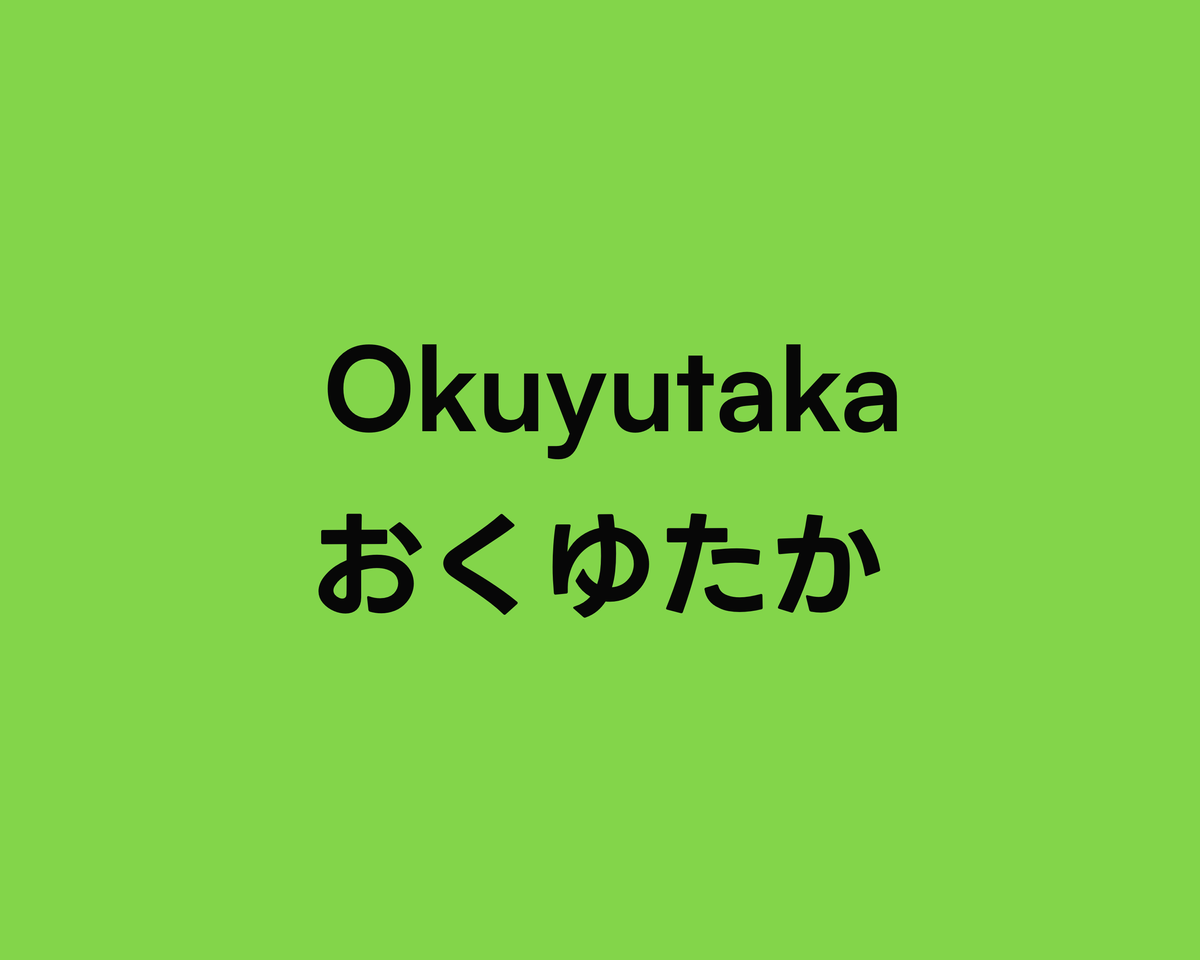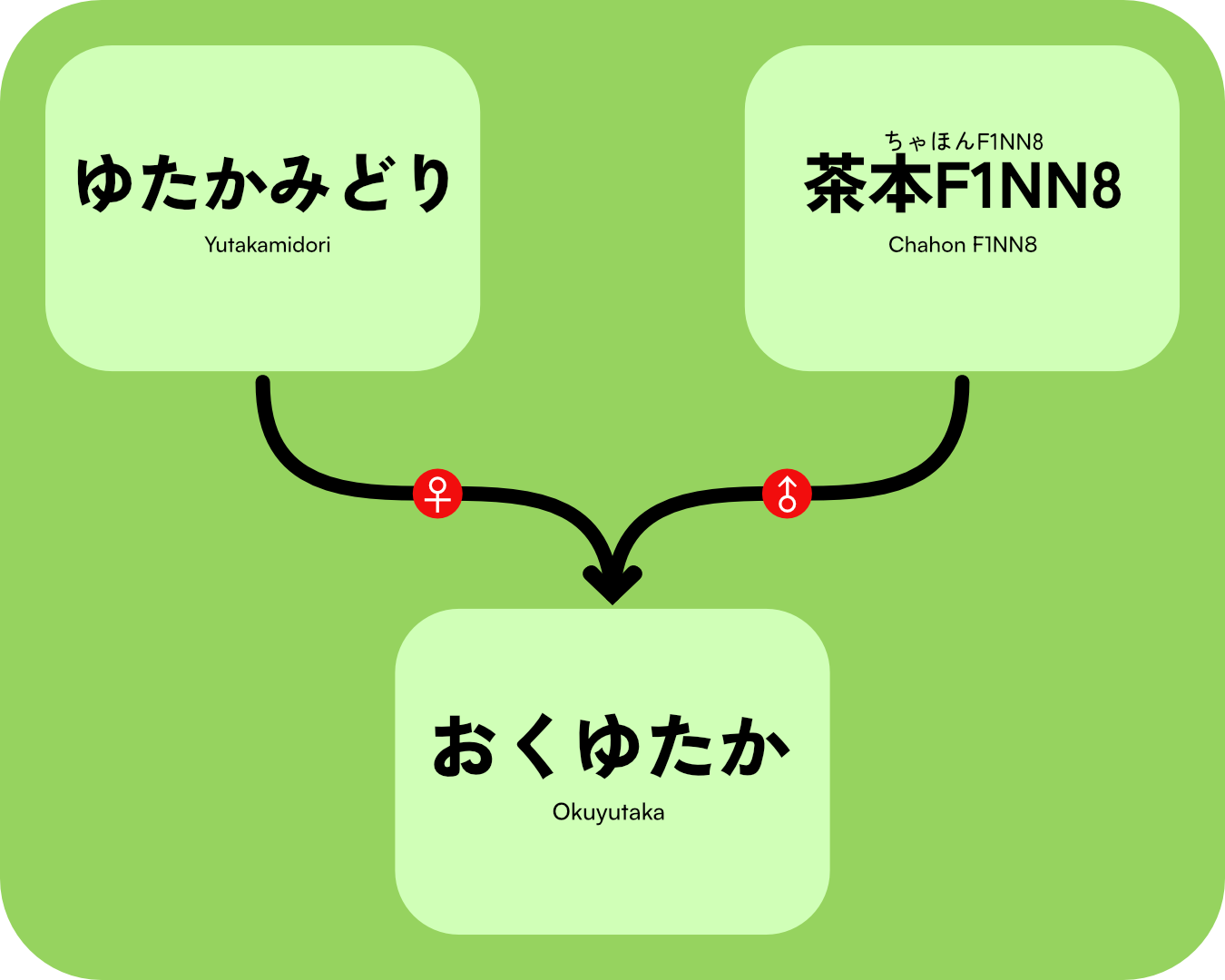Okuyutaka おくゆたか

Genealogy
♀: Yutakamidori ゆたかみどり
♂: 茶本F1NN8

History
Okuyutaka is a sencha cultivar result of crossing Yutakamidori ゆたかみどり as the flower parent and 茶本F1NN8 as the pollen parent performed in 1983. It was selected from the seedlings of that crossing at the Ministry of Agriculture, Forestry and Fisheries Tokai Kinki Agricultural Experiment Station in 1958. The site is currently the Ministry of Agriculture, Forestry and Fisheries Tea Experiment Station in Kanaya, it changed name sometime in the 60s together with some other changes around the ministries.
Yutakamidori is an unregistered cultivar selected from seeds of Asatsuyu in 1949. Primarily grown in the Kagoshima prefecture due to its low tolerance to cold weather. Interestingly enough, it is the second most grown cultivar in Japan. Although still very far away from the mainstay Yabukita, Yutakamidori represents around 7% of the cultivated tea in Japan as of 2023 and about 26% of the grown tea in Kagoshima. That is close to the area of cultivated Yabukita in Kagoshima, which is at around 30%. Chahon F1NN8, the pollen component of Okuyutaka is a crossing of Tamamidori, a Zairai from Kyoto prefecture and S6 or Shizai nº6, a Zairai from Shizuoka.
All initial breeding tests were conducted at the research station from 1958 to 1961. The cross-pollination was made in October 1958 and the seeds of that crossing were harvested in 1959 then transplanted in April 1960. Those seedling grown until 1963 and from 1964 they underwent a selection process, in 1965, the seedling that would become was selected in the initial round and then again in a second round in 1966. From 1967 it was named Chahon F1NN50, at this point it was tested extensively against other strains from the selections made for around 10 years, until 1976. Those included parallel tests common in cultivar breeding like adaptability tests, characteristics tests, propagation tests and others. In 1974, it was selected for wider adaptability test, and it was renamed as Kanaya No. 3 from 1975 as the seedlings were distributed to other test sites for the adaptability tests. Those areas included prefectures around Japan, expanding year by year to a total of 19 sites in 1978.
Another test that the strain was submitted to was the laceration type frost damage test. Designed to test the ability of the plant to withstand and recover from cold related injuries. It is a test commonly performed in the Kagoshima Prefectural Tea Experiment Station, and you can see mentions of it in many other cultivars breeding release papers. This test is important as, together with the local adaptability test, it will be used for recommended prefectures for growing the cultivar. It will also dictate it is promoted or dropped from the registration process. In the case of Okuyutaka, the results were excellent up to the final tests in 1982 that it was submitted as a candidate for sencha cultivar at the Tea Industry Division Specialist General Review Meeting Breeding Subcommittee in February 1983. After revision, it was judged suitable and an application for registration in the MAFF registry was submitted on the 26th of May 1983 as tea cultivar No. 34. Okuyutaka is named after its flower parent, Yutakamidori, with the oku component added to signify it mid-late growing characteristics.
Characteristics
Okuyutaka is a sencha cultivar with an intermediate shape with well-developed stems and a high number of branches. The root stock is good and the rooting of the cuttings is also good. The tea leaves are round, glossy, with a bit of wrinkling and reported a slightly thicker and slightly smaller leaves when compared to Yabukita. The shoots are long and the new leaves are slightly darker green. Glossier, thicker and larger than the ones from Yabukita, with a more elliptic shape The 100 bud weight is heavier than that of Yabukita and the number of shoots is medium. Seedlings are easy to grow with high survival rate with good root establishment and grow vigorously. In particular on more mature 4-5 year old seedlings, where it outpaces the growth and height of Yabukita.
The budding period is about 8 days later than Yabukita, and the first tea harvesting period is about 6 days later. It grows slightly earlier than Okumidori and about the same time as Kanayamidori, making it a late medium growing cultivar. Yield is higher than Yabukita, almost doubling it in certain test sites and seasons, but generally around 50% higher yields overall.
It is less susceptible to cold damage in the field, than Yabukita, while comparable in terms of severe damage. And its cold tolerance is comparable to that of resistance in severe cold. The incidence of anthracnose is low, and no other diseases weaknesses were observed during testing. Due to its relative resistance to cold, it is a cultivar recommended for usage south of the Tokai region, so relatively southern areas from Shizuoka and Gifu Prefectures. This also includes mountainous areas, where cold is an important factor to consider. Mie, Kyoto, Kochi, and Kumamoto are prefectures mentioned in the research papers as prefectures that will include Okuyutaka into their promoted cultivars. This is due to being a good cultivar to grow alongside Yabukita and slightly earlier harvest than late cultivars like Okumidori, so it allows for a good distribution of labor.
The appearance of the processed leaves is large but allows for a good compacted shape. It has a different aroma than other cultivars. In the release report, it is stated that because it is not a cultivar where the parent is Yabukita, it does not share many characteristics found in other cultivars. Taste is mild and with umami, interestingly it has a significantly higher amounts of amino acids, doubling the results achieved with Yabukita in the tests. As for catechin content, it is slightly lower amounts, with more content of caffeine than Yabukita, bringing a different balance to the cup.
Many prefectures reported in the study promising quality and growing results. In either the promising or extremely promising grades. Especially in southern areas like Kyushu but also in Kochi, on Shikoku island.
References
農林水産省野菜・茶業試験場 [編]『茶業試験場研究報告』(19),農林水産省野菜・茶業試験場,1983-09. 国立国会図書館デジタルコレクション https://dl.ndl.go.jp/pid/2380194.
